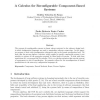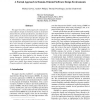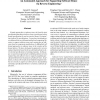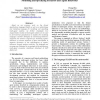90
Voted
CLEIEJ
2004
15 years 17 days ago
2004
ept of reconfigurable systems is almost always restricted to the abstract design level, in which configuration languages are used to manipulate software connections. In this paper...
82
Voted
CACM
2010
15 years 25 days ago
2010
Therearemanymethodsfordetectingandmitigatingsoftware errors but few generic methods for automatically repairing errors once they are discovered. This paper highlights recent work ...
90
Voted
JISBD
2001
15 years 2 months ago
2001
In this paper we show how the formal specification of a system written in Maude can be easily connected to its Web-based distributed implementation using SOAP. In addition to the u...
117
Voted
DSN
2008
IEEE
15 years 2 months ago
2008
IEEE
Fault-tolerant, replicated file systems are a crucial component of today's data centers. Despite their huge complexity, these systems are typically specified only in brief pr...
112
Voted
APSEC
2004
IEEE
15 years 4 months ago
2004
IEEE
Domain testing, a technique for testing software or portions of software dominated by numerical processing, is intended to detect domain errors that usually arise from incorrect i...
102
click to vote
KBSE
1994
IEEE
15 years 4 months ago
1994
IEEE
This paper describes a formal approach to domain-oriented software design environments, based on declarative domain theories, formal specifications, and deductive program synthesi...
97
Voted
KBSE
1998
IEEE
15 years 5 months ago
1998
IEEE
Formal approaches to software reuse rely heavily upon specificationmatchingcriterion, where asearch query using formal specifications is used to search a library of components ind...
106
Voted
ICSE
2001
IEEE-ACM
15 years 5 months ago
2001
IEEE-ACM
This paper summarizes an approach for introducing component-based software engineering (CBSE) early in the undergraduate CS curriculum, and an evaluation of the impact of the appr...
94
Voted
IAT
2003
IEEE
15 years 6 months ago
2003
IEEE
Based on our previous work on the formal specification language SLABS as well as a methodology and modelling language for modelling and specifying multi-agent systems, we further ...
106
click to vote
SELMAS
2004
Springer
15 years 6 months ago
2004
Springer
Abstract. This paper presents an agent-oriented modelling language and environment CAMLE. It is based on the conceptual model of multi-agent systems (MAS) proposed and formally def...




